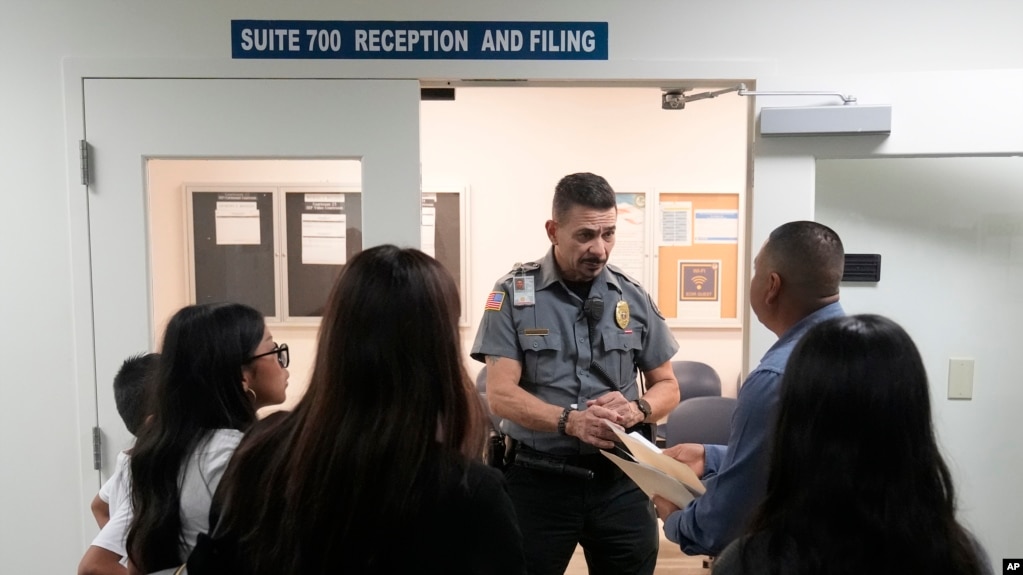AUDIO
Asylum Seekers’ Court Cases Keep Growing

The record number of immigrants entering the United States illegally has resulted in 3 million cases awaiting judgement in immigration courts around the country.
The city of Miami, Florida, is at the center of the immigration wave. There, 261,000 removal proceedings are awaiting a hearing.
Just 12 years ago, that number would have covered the whole country, said Austin Kocher. He is a professor at Syracuse University in New York who researches federal immigration detention.
The Associated Press (AP) reports that Miami has the longest list, or docket, of these cases. The backlog includes immigrants who have been in the United States for many years but were arrested on charges not related to their entry into the country.
Most, however, are asylum seekers. They have told border security officials that they fear they will be in danger if they return to their home country.
The AP reports that the number of people being apprehended for illegally crossing the southern U.S. border has reached record levels. As a result, the court backlog of cases grew by more than 1 million in the last fiscal year.
Information from Syracuse University’s Transactional Records Access Clearing house says the case backlog is three times larger than it was in 2019.
Judges, lawyers and migrant activists say they are worried the system no longer works.
It often takes several years to either grant people asylum or deport those who have no right to remain in the country.
The courts are administered by the Department of Justice. The backlogged courts have received limited attention.
What happens at the border?
When U.S. officials apprehend migrants at the border, a record is made of their detention. Most are then released into the U.S. and are told to appear in court in the city where they are headed. The information is passed from the Department of Homeland Security to the Justice Department, where the Executive Office for Immigration Review operates the courts.
Randy McGrorty is executive director of Catholic Legal Services for the Archdiocese of Miami, which has hundreds of thousands of migrants in its communities. He said, “They’re just being released without any idea of what comes next.”
Many immigrants come to the Catholic Legal Services for advice. It is now teaching them how to represent themselves before judges.
Miguel Mora is a Catholic Legal Services lawyer in Miami. He said, “We help them understand what judges want, and we help judges…”
When immigrants go to court
Aaron Rodriguez and Cindy Baneza are in their 20s. They recently appeared in an immigration court in Miami with three children. They are not married.

Aaron Rodriguez, right, and Cindy Baneza, center, leave an immigration court in Miami, Wednesday, Jan. 10, 2024, after a judge granted them more time to find an attorney to file for asylum. (AP Photo/Wilfredo Lee)
They communicated with the judge with the help of an interpreter. It had been eight months since they crossed the Rio Grande River and entered the U.S. illegally. They asked the judge to give them more time to find a lawyer so they could file an asylum claim.
Rodriguez, who is 23, told Judge Christina Martyak that he had no money for a lawyer. He had already received an extension for not having a lawyer.
Rodriguez and Baneza said they fled Honduras after a gang threatened them. The violent group had killed the father of Baneza’s oldest child. The gang threatened them with more violence unless they paid them money they earned from their tortilla business.
Rodriguez told the AP: “We were left with no other option than get out of the country.”
Judge Martyak agreed to give Rodriguez and Baneza an additional three months. She told them to seek free legal assistance from the Catholic Archdiocese of Miami.
The backlog keeps growing
Time does not reduce the backlog, however. Government records show that judges completed far more cases in the last year than ever before. But their dockets keep growing.
Mimi Tsankov is president of the National Association of Immigration Judges. Tsankov said the average number of cases per judge is now 5,000. She said if the number of judges doubled to about 1,400, the current backlog would be solved by 2032.
In the latest budget request, the Executive Office for Immigration Review said it is requesting that Congress provide money for 150 new judges and support workers, the AP reports.
Paul Schmidt is a retired immigration government lawyer. He was working when the last major system reform took place nearly 40 years ago. He said the system can only be fixed with major policy changes. One example of such a change would be to permit most asylum cases to be solved through an administrative process instead of through a court of law.
________________________
Words in This Story
proceedings –n.(pl.) the process of appearing before a court of law in a legal case
backlog –n. the number of tasks that are waiting to be finished
apprehend –v. to be caught or to be arrested
fiscal year –n. a 12-month period for financial purposes
grant –v. to give legal permission for something in an official way
deport –v. to be removed from a country by a legal process
file –v. to submit documents to meet legal or financial requirements; to put paperwork in organized storage
https://learningenglish.voanews.com/a/asylum-seekers-court-cases-keep-growing/7445510.html